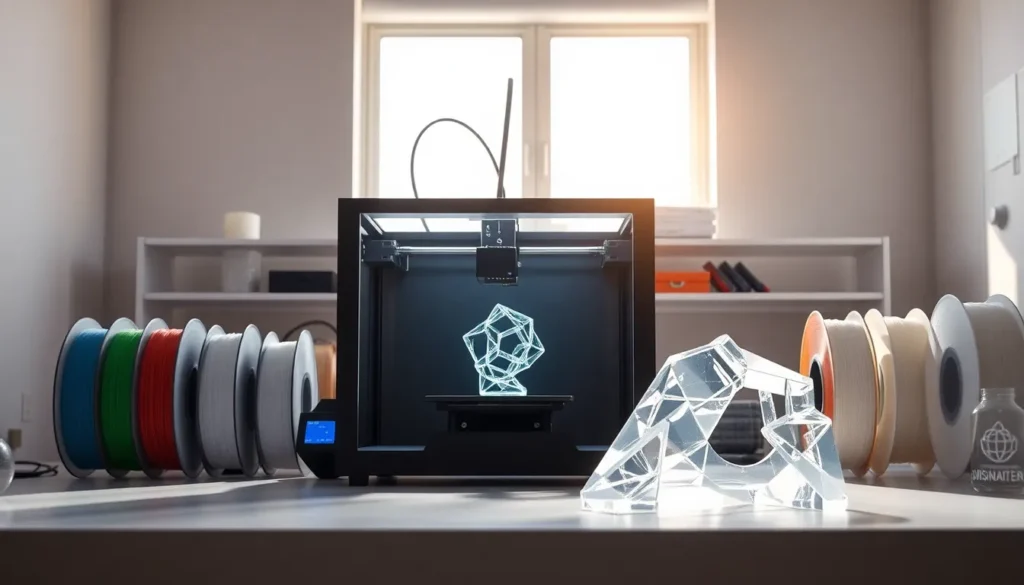Ever wondered how those crystal-clear 3D printed objects are created? It’s time to peel back the curtain on transparent 3D printing filament. This game-changing material might just become your new best friend in the world of 3D printing. From eye-catching prototypes to innovative designs that demand attention, transparent filament offers a wealth of opportunities. Is it magic? Nope, just advanced materials at play. Buckle up, because we’re diving deep into the sparkling world of transparent filaments that will make your 3D printed dreams come true.
Table of Contents
ToggleWhat Is Transparent 3D Printing Filament?

Transparent 3D printing filament is a specialized material that allows light to pass through, resulting in stunningly clear prints. Generally made from thermoplastics like PLA (Polylactic Acid) and PETG (Polyethylene Terephthalate Glycol), transparent filaments maintain structural integrity while showcasing objects with minimal visibility.
When printing, this filament can produce glass-like finishes, making designs appear elegant and sophisticated. Think of it as the fancy restaurant of filaments, offering the same function as traditional materials but with a dash of flair. For those who want that wow factor without compromising quality, transparent filament is a top contender.
Types of Transparent 3D Printing Filaments
There are several types of transparent 3D printing filaments, each with its own unique properties. Let’s highlight a few crowd-pleasers:
1. PLA
PLA is the most commonly used filament in 3D printing, and transparent variants are no exception. It’s biodegradable and easy to print, making it perfect for beginners. But, keep in mind that while PLA is easier to work with, it might not offer the same durability as other materials.
2. PETG
PETG stands out for its strength and flexibility, making it an excellent choice for functional parts. This filament tends to be more impact-resistant than PLA, allowing for some nifty design possibilities. The transparency of PETG versions can rival that of glass.
3. ASA
Ideal for outdoor use, ASA (Acrylonitrile Styrene Acrylate) is resistant to UV light and weathering. Its transparent options are robust and maintain clarity while standing up to the elements. If the sun is shining, ASA is your go-to buddy.
4. PC
Polycarbonate filaments are known for their exceptional strength, often used in industrial applications. While they can be challenging to print, the results are worth the effort. Clear PC can produce prints that are both durable and visually striking.
Choosing the right filament largely depends on the requirements of the specific project, be it strength, flexibility, or aesthetic appeal.
Benefits of Using Transparent Filaments
Embracing transparent filaments opens the door to several advantages. Here’s why designers and engineers are increasingly adopting these materials:
1. Aesthetic Appeal
Let’s face it, clear prints are stunning. The ability to create sleek and polished items adds a professional touch to prototypes and final products. Clients and customers are impressed by visually striking items that showcase innovation.
2. Versatility
Transparent filaments can be used for any number of projects, from decorative pieces to industrial components, so broadening the range of applications. This flexibility means that one spool of filament can tackle multiple design challenges.
3. Light Interaction
These filaments are fantastic for creating items with unique light effects. They are perfect for lampshades, decorative art pieces, or anything where light plays a crucial role. The play of shadows and light can turn ordinary designs into extraordinary experiences.
4. Functional Use
While aesthetic qualities shine, many transparent filaments also boast remarkable physical properties. PETG, for example, offers durability along with clarity, meaning you can have your cake and eat it too, great looks paired with excellent functionality.
Choosing the Right Transparent Filament for Your Project
Picking the right transparent filament can be a task that feels akin to selecting a fine wine. Here’s what to consider:
1. Purpose of the Print
Determine whether the print is for aesthetic reasons or functional use. For decorative items, PLA might suffice, while functional parts may require the strength of PETG or PC.
2. Environment
Consider where the final product will be used. If it’s exposed to sunlight or outdoor conditions, reach for ASA or PETG, as these are more resilient to environmental factors.
3. Printing Conditions
Different filaments often require varied settings. PLA is typically forgiving, while materials like PC necessitate higher temperatures and precise print settings. Be ready to adjust your printer accordingly.
4. Desired Transparency Level
Transparency levels can differ among filament types. Sometimes, a little experimentation is needed to get that perfect glass-like finish, so keep that in mind during selection.
Tips for Successful Printing with Transparent Filaments
Navigating the world of transparent 3D printing can be a breeze with the right techniques. Here are some tried-and-true tips to achieve optimal results:
1. Temperature Settings
Pay attention to the temperature settings specific to each filament type. Higher temperatures often unlock better clarity. Keep your nozzle clean and the bed level to avoid print defects.
2. Print Speed
Slower printing speeds often yield better results when dealing with transparent filaments. This allows the material to settle nicely, leading to cleaner lines and fewer bubbles.
3. Layer Height
Consider using finer layer heights to improve transparency. Thinner layers can result in reduced visibility of the layer lines, creating that smooth, see-through look.
4. Post Processing
Sometimes, simple post-processing techniques like polishing or sanding can enhance transparency further. Consider using a clear coat for an extra touch of shine.
Common Applications of Transparent 3D Printing Filament
Transparent filaments lend themselves beautifully to a variety of applications. Here are a few notable uses:
1. Prototyping
Engineers and designers often use transparent filaments to create prototypes that provide clarity on design and functionality. Clear prototypes generally allow stakeholders to visualize and interact with products efficiently.
2. Light Fixtures
In the world of lighting, transparent filaments can create stunning lamps and light diffusers. These items not only show off beautiful designs but also enhance light aesthetics, creating inviting atmospheres.
3. Art and Decor
Artists use transparent filament to produce innovative sculptures and decorative pieces that catch the eye. The layering and light interplay can elevate art to new heights.
4. Display Cases
Collectors and store owners appreciate transparent 3D prints for display cases that showcase products elegantly while preserving visibility. This functionality makes transparent filaments a favorite in retail spaces.
Challenges and Limitations of Transparent Filaments
While transparent filaments add a spark to any project, they’re not without their challenges. Here are some considerations:
1. Printing Complexity
Working with transparent materials can be tricky, especially for those new to 3D printing. They often require precise settings and technical knowledge, which can be daunting for beginners.
2. Clarity Issues
Achieving pristine transparency might take a few attempts. Factors such as layer height, print speed, and ambient conditions can impact clarity, sometimes requiring additional trial and error.
3. Cost
Transparent filaments are often priced higher than standard materials. Budget-conscious creators may need to weigh the costs versus the benefits of using these materials for a specific project.










